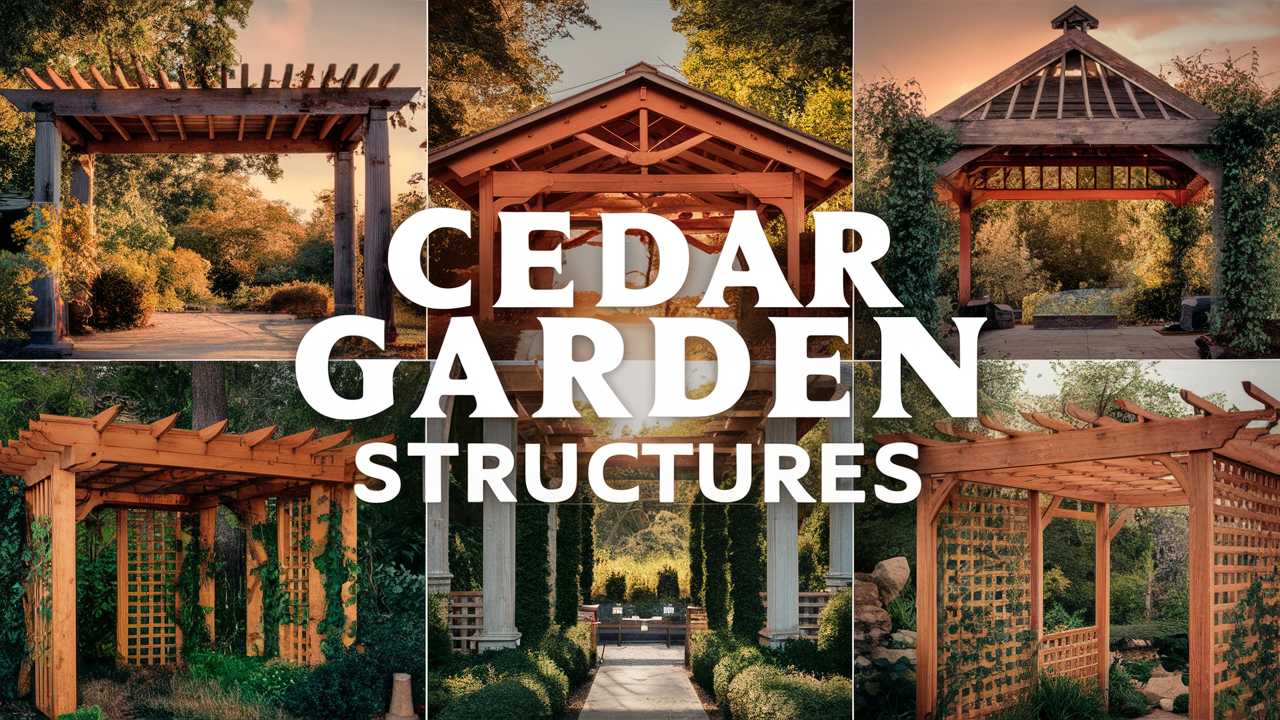If you’re looking to add charm, structure, and value to your garden, here are some unique and compelling cedar garden structure ideas that can transform your outdoor space into a personal oasis.
View this post on Instagram
Here’s a cute idea for a trellis; I think it’s a great way to add a bit of structure and height, especially if you have a smaller garden. I like how simple and clean the lines are – it would look really nice with some climbing roses or clematis. The top piece gives it a little extra flair too, don’t you think? It would even look great just as a stand-alone architectural element.
View this post on Instagram
I’ve been loving the idea of using cedar trellises to add some vertical interest in my garden! These simple cedar structures, spaced out along a wall, really let the climbing plants shine. I’d space mine out a little and use a different colored flower with it. It is a good way to add a pop of color against a plain wall, and the cedar is so durable, it will last for years. I think the cleanness of the cedar will make a very clean and classy look for any home.
View this post on Instagram
Here is one idea. I really like how this cedar pergola is integrated with the hardscaping, don’t you? The pavers create a nice patio space that blends seamlessly with the raised garden bed. Plus, those cedar posts anchoring the structure have a really warm, natural look. Imagine stringing some lights across the top – instant cozy atmosphere! Think of the fun you can have customizing something like this.
Cedar Garden Structure Ideas
Cedar wood has long been a favorite among gardeners and landscape designers for its rich color, durability, and natural resistance to decay and insect infestations. Utilizing cedar in your garden opens up a plethora of design possibilities that not only enhance aesthetics but also elevate functionality.
Cedar Arbors: A Gateway to Beauty
Cedar arbors serve as stunning focal points in any garden and act as gateways to your garden paths or seating areas. These structures can be left open or adorned with climbing plants like wisteria, roses, or honeysuckle, adding both visual interest and fragrance.
Crafting Your Arbor
When designing an arbor, consider the scale of your garden. A larger space can accommodate an impressive, towering arbor, while a smaller garden would benefit from a more modest design. Adding built-in benches can create a charming nook for rest and reflection, making it both an aesthetic and functional element.
Customization Options
For a personalized touch, consider adding lattice panels to your arbor’s sides for increased vine support or even installing solar lights for evening illumination. The versatility of cedar allows you to create a structure that fits your style, whether rustic, modern, or somewhere in between.
Cedar Raised Garden Beds: Style Meets Function
Raised garden beds made from cedar are not only visually appealing but also offer practical advantages. They improve drainage, provide better soil control, and reduce bending and kneeling when planting and caring for your plants.
Designing Your Beds
When designing cedar raised garden beds, think about their dimensions. A height of 12 to 24 inches allows for proper root health and easier maintenance. An intricate design with varying heights can be visually striking and functional, accommodating different types of plants based on their needs for sunlight and moisture.
Enhancing Your Garden Beds
Consider adding a trellis or screening on one side of the bed. This can serve as a supportive structure for climbing plants or a privacy screen, adding both interest and utility to your garden space.
Cedar Pergolas: Shade and Style
Cedar pergolas are versatile structures that can elevate your outdoor living area. They provide partial shade while still allowing sunlight to filter through, creating a tranquil space for relaxation or dining.
The Perfect Placement
Position your pergola strategically in your garden to maximize views and incorporate seating areas beneath it. Adding outdoor furniture like a dining set or a cozy lounge area transforms the space into a delightful retreat.
Integration with Nature
To further enhance the structure, consider intertwining vines like grape or jasmine, which will cascade over the beams, creating a natural canopy. This not only adds a stunning visual element but also infuses your space with delightful scents.
Cedar Trellises: Vertical Gardening Solutions
If you’re short on ground space but still want to grow a variety of plants, cedar trellises can be a perfect solution. These vertical structures can support climbing plants and vegetables, maximizing your garden’s productivity.
Designing Your Trellis
The design of your trellis can range from simple, classic A-frame designs to more elaborate laced patterns. Experiment with different shapes and sizes according to the space available and the types of plants you’re growing.
Functional Features
Consider integrating a few shelves into your trellis for additional planting or decorative display. This can not only enhance the trellis’ functionality but also elevate the overall aesthetic of your garden.
Cedar Fencing: Privacy with Panache
A cedar fence can create a sense of enclosure in your garden while adding character. Its natural resistance to the elements makes it ideal for outdoor use, and its warm, rich tones complement any landscape.
Choosing the Right Style
From minimalist slats to intricate lattice designs, there are countless fencing styles. Choose a fence height that promotes privacy without overwhelming your garden space.
Adding Accents
Accessorizing your cedar fence with climbing plants can create a beautiful living fence. Install planters along the base to grow a selection of flowers or herbs, reinforcing the natural aesthetics of your outdoor area.
Cedar Gazebos: A Cozy Retreat
For those looking for a dedicated outdoor lounging area, a cedar gazebo offers the perfect solution. This sheltered structure can accommodate seating, dining, or even hot tubs, providing a versatile space for entertaining or relaxation.
Crafting Your Gazebo
Pay attention to details when building your gazebo. Features like open or enclosed designs can alter the comfort level according to the season, while additional elements like screens or curtains can protect against insects.
Enhancing the Experience
Consider adding solar panels to power lights or speakers within your gazebo, transforming it into a gathering space for social events. Additionally, incorporating natural stone or gravel paths leading to the gazebo can enhance its visual appeal.
Cedar Compost Bins: Eco-Friendly Organization
Incorporating a cedar compost bin into your garden structure not only promotes eco-friendliness but also encourages sustainability. A well-built compost bin made of cedar can beautifully integrate into your garden while fulfilling a practical purpose.
Structuring Your Compost Bin
Designing your compost bin can be a creative endeavor. Opt for a three-sided structure with a simple hinged door for easy access. Ensure there is adequate ventilation with slats or gaps to allow airflow for decomposition.
Aesthetics Meets Functionality
You can enhance the design of your compost bin by matching it with other cedar structures in your garden. This uniformity creates an organized appearance while promoting a cohesive design throughout your outdoor space.
Cedar Garden Furniture: Comfort Meets Design
Cedar garden furniture, including benches, tables, and loungers, brings comfort to your garden while offering an inviting place to unwind. The natural beauty of cedar will appeal to those looking for functional and aesthetic enhancements.
Choosing the Right Pieces
Consider your intended use when selecting furniture. A spacious cedar dining table can serve as a focal point for family gatherings, while a couple of benches or loungers can create a quaint relaxation space.
Maintenance and Longevity
Regular maintenance, such as oiling or sealing your cedar furniture yearly, ensures your pieces remain in pristine condition while enhancing their longevity. This no-fuss environmental choice makes cedar furniture a great long-term investment for your garden.
Cedar Pathways: Defining Space with Style
Cedar pathways add structure to your garden while guiding the visitor’s experience. These paths provide a sense of direction and can be designed to complement the plant life surrounding them.
Pathway Designs
From straight paths to winding trails, your choice of layout should reflect the natural flow of your garden. Adding cedar planks or even split logs creates a rustic look that seamlessly blends with your surroundings.
Boundary Marking
Incorporating garden edging alongside your pathway can help define different areas in your garden. This not only maintains order but also supports the visual aesthetic of your outdoor space.
Cedar Support Structures: The Backbone of Vertical Growth
Support structures for plants, such as stakes, cages, or frames made from cedar, are essential in maintaining healthy garden conditions. These not only aid in plant health but also contribute to the overall landscape design.
Building Frameworks
Craft support structures to match the scale of your plants; for instance, use climbing frames for sweet peas, or sturdy poles for tomatoes. Keep your framework visible yet integrated within the garden.
Aesthetic Appeal
By using cedar, you not only provide the necessary structural support for your plants but also enhance the visual style. Adding decorative elements such as finials or ornamental caps can create interest and sophistication in your garden.
Cedar Birdhouses: Attracting Wildlife
Adding cedar birdhouses enhances your garden’s income, attracting beneficial wildlife, particularly birds that help control pests. They also add an element of charm and a touch of whimsy to your landscape.
Building Your Birdhouse
Choose a design that meets the needs of local bird species. Incorporate proper drainage and ventilation to ensure it remains habitable.
Personalized Touches
Decorate your birdhouses in accordance with your garden’s color scheme or style. Painting them in bright colors can add a pop of personality and invite more visitors into your garden.
Cedar Border Planters: Defining Spaces with Foliage
Cedar border planters can serve as natural dividers in your garden, allowing you to delineate different areas for shrubs, flowers, or vegetables. These elements blend beauty with structure and can significantly enhance your garden design.
Custom Planters
The size and shape of your border planters can vary enormously. Tall and slender designs can host perennials or small trees, while wider planters can allow for a variety of flowers and herbs.
Cohesive Design
Matching the wood finish of your border planters with other cedar structures ensures a cohesive appearance throughout your garden. Consider lining the tops with outdoor cushions or seasonal decor to create a warm, inviting atmosphere.
Final Thoughts
Cedar garden structures offer an alluring fusion of durability and aesthetics. When designed thoughtfully, these structures can elevate your outdoor space while providing practical benefits, from enhancing walking paths to creating cozy leisure areas. Whatever your individual style or garden layout, incorporating cedar structures can open up a world of possibilities that transform your garden into a captivating sanctuary. Embrace the warmth, beauty, and charm of cedar, and let your outdoor imagination run wild!





